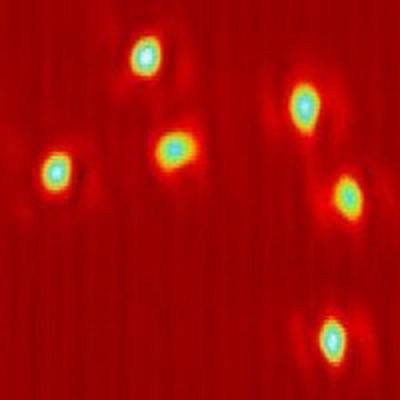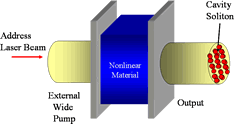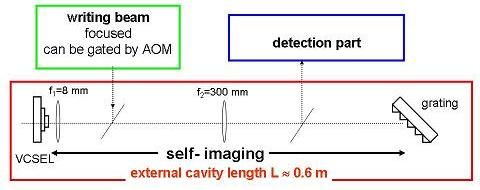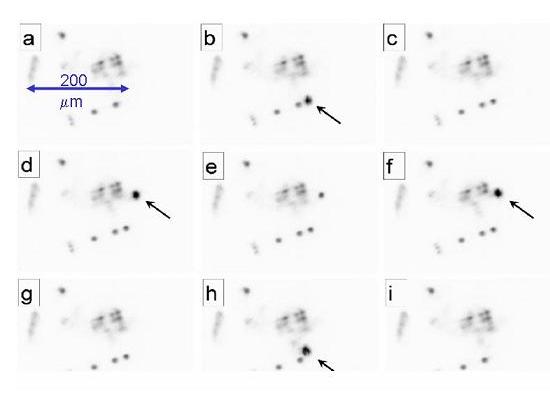Solitons and vector vortex beams in broad-area VCSELs

Introduction
Light does not stay confined to small regions in space or time, but wave packets of light have the natural tendency to broaden: In space this is due to diffraction, in time this is due to dispersion, at least in a medium. On the other hand, for optical communications, storage or future all-optical processing techniques, it is important to counteract this natural tendency and to confine light to the smallest possible dimensions. Though great partial success was achieved by linear optical element as optical fibres and other waveguides, it was always the dream of researchers to confine light by self-action. This is why the concept of solitary waves — or more loosely speaking of solitons — received a lot of attraction during the last decades. A soliton is a wavepacket in which the tendency to broaden is balanced by nonlinearities.

Cavity solitons (CS) are solitary waves in a nonlinear optical cavity.
Due to the outcoupling losses through the mirrors, spontaneous emission and nonradiative decay, cavities are actually a dissipative environment. Hence cavity solitons are an example for dissipative solitons. This has important consequences:
-
They have fixed amplitude and width for constant parameters.
-
They have bistable, i.e. can be present or absent under the same conditions.
-
Within the bistable range, one can set and reset them by external optical control beams.
-
‘They possess mobility (in contrast to micro-machined pixels): Since they are self-localized, they can exist anywhere within a pumped area on the one hand and react to any – possibly dynamical gradients on the other hand.’
Hence, they have potential in future all-optical processing applications. We are using the concept of a cavity soliton to realize small microlasers within a broad-area vertical-cavity surface-emitting laser (VCSEL). These can be switched on and off by optical means.
We term this device a cavity soliton laser.
Cavity soliton laser: Experiment
For a realization, we use a VCSEL with 200 micron emission aperture with feedback from a grating serving as a frequency-selective element. The competition between two resonances, the cavity resonance of the VCSEL and the one by the grating filter, makes the system bistable. Initially, they are detuned and the VCSEL is in a zero amplitude emission states with a high carrier density. The two resonance can became aligned because a high amplitude emission state with a correspondingly lower carrier density leads to a change of intracavity refractive index and hence resonance condition.

For further explanations on the mechanisms underlying the cavity soliton laser see here.
Please Click Here for real time movie of spatial emission structure of a broad-area VCSEL showing the spontaneous switch-on and switch-off of laser solitons if the current is ramped up and down slowly.

This figure shows the intensity distribution within the active area of the VCSEL. It demonstrates the independent switch-on and switch-off of two microlasers with an external control beam (arrow). Obviously, you can set and reset laser emission by optical means similar to setting and resetting an electronic flip-flop. The individual microlasers have a size of about 5 microns
Click Here for a video showing the independent writing and erasure of all 23=8 bit combinations possible for three solitons demonstrating the possibility of a complete external control of emission state (see IEEE J. Quant. Electron. 2009 for details)
Current work is directed on understanding and controlling the choice of frequency, phase and polarization of these guys and how this influences their interaction. For applications, miniaturization is required.
Coverage and Esteem
- Editor’s suggestion in Physical Review Letters: A step toward 3D self-localization and light bullets: Observation of Mode-Locked Spatial Laser Solitons

- Invited talk on Complex States of Laser Solitons: Anti-Vortices and Mode-Locking at pdnoc16 — International Tandem Workshop on Pattern Dynamics in Nonlinear Optical Cavities, Dresden, Germany, Aug 15-19, 2016.
- Invited book chapter on Dynamics and Interaction of Laser Cavity Solitons in Broad-Area Semiconductor Lasers published in book on Nonlinear Optical Cavity Dynamics
- Plenary talk on Dynamics and Interaction of Laser Cavity Solitons in Broad-Area Semiconductor Lasers at THE SECOND INTERNATIONAL WORKSHOP “NONLINEAR PHOTONICS: THEORY, MATERIALS, APPLICATIONS – NP $\hbar$’15, St. Petersburg, Russia, June 29 – July 02, 2015.
- Invited talk on dissipative vortex solitons and azimuthons at The Nonlinear Meeting, Edinburgh, May 17-22, 2014.
- Invited talk on laser soliton dynamics at NDSL14 International Workshop: Nonlinear Dynamics in Semiconductor Lasers, Berlin, May 12-14, 2014.
- Invited lectures on broad-area lasers and laser solitons at ICTP-SAIFR School on Nonlinear Optics and Nanophotonics, IFT-UNESP, Sao Paulo, Brazil (Dec 2013).
- Invited talk on VCSEL vortex solitons at ENOS 13 – Extreme Nonlinear Optics & Solitons (Oct 2013).
- Invited lecture: Dissipative solitons and spatial structures in optical system at Photonics@be Doctoral School
- LabTalk: Observation of laser vortex solitons
- A new take on coupled lasers: Adler synchronization of spatial laser solitons pinned by defects published in Phys. Rev. Lett.
- Review article: T. Ackemann, W. J. Firth, G.-L. Oppo. Fundamentals and Applications of Spatial Dissipative Solitons in Photonic Devices. Adv. Atom., Mol., Opt. Phys. 57, 323-421 (2009)
- SPIE Newsroom: Light-controlled microlasers (2009)
- First realization of semiconductor cavity soliton laser published in Phys. Rev. Lett. (2008) Featured in physicsworld.com (Solitons Underpin new laser), optics.org, Optics & Laser Europe 159 (3),p.12 (2008), 2physics.com
- All optical delay line based on cavity solitons hits title page of Applied Physics Letters.
Recent publications
People
Collaborations
- CNQO Group (Strathclyde)
- R. Jaeger (Ulm Photonics)
- D. Kane (Macquarie University, Sydney)
- P. Colet, D. Gomila (IFISC, Palma de Mallorca)
- K. Panajotov (VUB Brussels)
Former Group Members and Collaborators
- Dr Yoann Noblet
- Mr. Jesus Jimenez Garcia
- Dr. Neal Radwell-
- Dr. Y. Tanguy
- Mr. Craig McIntyre
- Group of N. A. Loiko (Belorussian Academy of Science, Minsk)
- C. Denz (Institut fuer Angewandte Physik, WWU Muenster)
- N.N. Rosanov (St. Petersburg)
- FunFACS partners
Funding
- Royal Society, Complex Laser Dynamics: Analysis and Control 07/2013 – 06/2016
- EU-STREP 4868 FunFACS: Fundamentals, Functionalities and Applications of Cavity Solitons 04/2005 – 09/2008
- British Council ARC 1267 Control of laser devices and solitons by light-induced photonic crystals 08/2006 – 07/2008
- Royal Society (PI W. Firth) Hybrid Solitonics 08/2006 – 09/2008